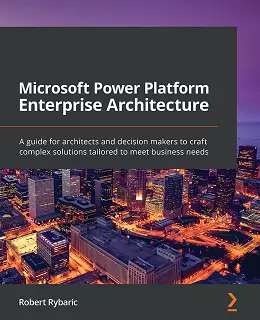Microsoft Power Platform Enterprise Architecture

eBook Details:
- Paperback: 403 pages
- Publisher: WOW! eBook (October 9, 2020)
- Language: English
- ISBN-10: 1800204574
- ISBN-13: 978-1800204577
eBook Description:
Microsoft Power Platform Enterprise Architecture: Gain a 360-degree view of Microsoft Power Platform and combine the benefits of Power Apps, Power BI, Power Automate, Azure, and Dynamics 365 to build an enterprise application platform for your organization
Microsoft Power Platform combines the functionality of Power Apps, Power Automate, Power BI, and Power Virtual Agents into one robust business application platform for building sophisticated business solutions quickly. This book covers the new Microsoft philosophy of ‘Power Platform as a foundation for business solutions’ and shows you how to integrate other Microsoft products to build complex solutions tailored to your business needs.
You’ll start by learning about the key components of the Microsoft 365 ecosystem, along with various methodologies, tools, and techniques that will help you to build a strong foundation for implementing a Power Platform project. As you advance, you’ll delve into the Power Platform architecture and find out about various clients, administration and monitoring portals, and architectural best practices. You’ll also explore Power Platform’s security and extensibility model and learn to customize it according to your project needs. Finally, you’ll overcome various challenges in migrating data to and from Microsoft Power Platform and also understand the custom integration possibilities within a Power Platform solution and various Microsoft 365 and Microsoft Azure components.
- Get to grips with the structures of Microsoft Dynamics 365 CRM, ERP, and AI modules for creating Power Platform solutions
- Explore various Microsoft 365 and Microsoft Azure components and understand how they enhance Power Platform solutions
- Find out which regions, staging environments, user types, and user licensing groups to employ when creating enterprise solutions
- Implement a sophisticated security model in Power Platform by using various authentication and authorization concepts
- Extend Power Apps, Power BI, and Power Automate to create custom applications
- Integrate your Power Platform solution with various in-house Microsoft components or external third-party systems using integration patterns
By the end of this Microsoft Power Platform Enterprise Architecture book, you’ll be able to architect, design, and manage a complex Power Platform solution.



